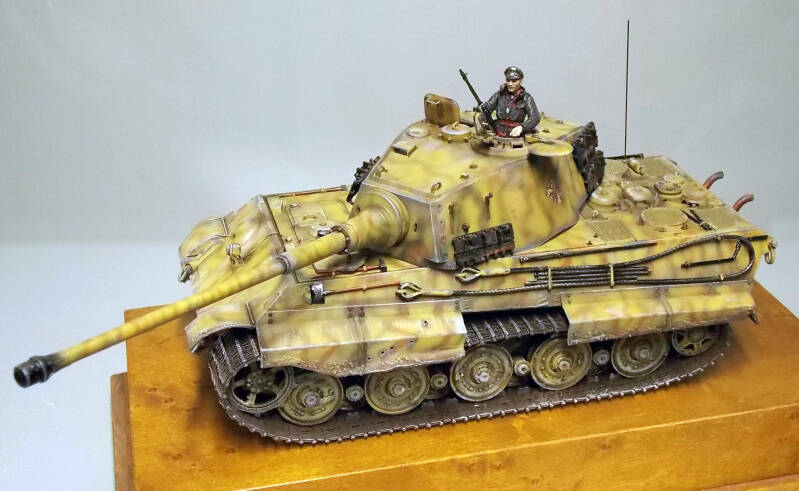TIGER II
The Tiger II is a German heavy tank of the Second World War. The final official German designation was Panzerkampfwagen Tiger Ausf. B, often shortened to Tiger B, the ordnance inventory designation was Sd.Kfz. 182. It was known as King Tiger by Allied soldiers, and is also known under the informal name Königstiger. Though the name Königstiger was never used in contemporary German documentation, but was used extensively after the war.
The Tiger II was the successor to the Tiger I, combining the latter's thick armour with the armour sloping used on the Panther medium tank. The tank weighed almost 70 tonnes, and was protected by 100 to 185 mm (3.9 to 7.3 in) of armour to the front. It was armed with the long barrelled 8.8 cm KwK 43 L/71 anti-tank cannon. The chassis was also the basis for the Jagdtiger turretless Jagdpanzer anti-tank vehicle.

Development of a heavy tank design had been initiated as early as 1937; the initial design contract was awarded to Henschel. Another design contract followed in 1939, and was given to Porsche. Both prototype series used the same turret design from Krupp; the main differences were in the hull, transmission, suspension and automotive features. Both firms contented for the production of the Tiger I and Tiger II during the war, Henschel winning both contracts.
Two turret designs were used in production vehicles. The initial design is often misleadingly called the "Porsche" turret due to the misbelief that it was designed by Porsche for their Tiger II prototype; in fact it was the initial Krupp design for both prototypes. This turret had a rounded front and steeply sloped sides, with a difficult-to-manufacture curved bulge on the turret's left side to accommodate the commander's cupola. Fifty early turrets were mounted to Henschel hulls and used in action. In December 1943 the more common "production" turret, sometimes erroneously called the "Henschel" turret, was simplified with a significantly thicker flat face (which eliminated the shot trap caused by the curved face of the earlier turret), and less-steeply sloped sides, which avoided the need for a bulge for the commander's cupola, and added additional room for ammunition storage.

The turrets were designed to mount the 8.8 cm KwK 43 L/71 gun. Combined with the Turmzielfernrohr 9d (German "turret telescopic sight") monocular sight by Leitz, which all but a few early Tiger IIs used, it was a very accurate and deadly weapon. During practice, the estimated probability of a first-round hit on a 2 m high, 2.5 m wide target was 100 percent at 1,000 m, 95–97 percent at 1,500 m and 85–87 percent at 2,000 m, depending on ammunition type. Recorded combat performance was lower, but still over 80 percent at 1,000 m, in the 60s at 1,500 m and the 40s at 2,000 m.
Like all German tanks, the Tiger II had a petrol engine; in this case the same 700 PS (690 hp, 515 kW) V-12 Maybach HL 230 P30 which powered the much lighter Panther and Tiger I tanks. The Tiger II was under-powered, like many other heavy tanks of World War II, and consumed a lot of fuel, which was in short supply for the Germans.
Like the Tiger I, each tank was issued with two sets of tracks: a normal "battle track" and a narrower "transport" version used during rail movement. The transport tracks reduced the overall width of the load and could be used to drive the tank short distances on firm ground. The crew were expected to change to normal battle tracks as soon as the tank was unloaded.
The Tiger II was developed late in the war and built in relatively small numbers. Orders were placed for 1,500 Tiger IIs—slightly more than the 1,347 Tiger I tanks produced—but production was severely disrupted by Allied bombing raids Among others, five raids between 22 September and 7 October 1944 destroyed 95 percent of the floor area of the Henschel plant in Kassel. Only 492 units were produced: one in 1943, 379 in 1944, and 112 in 1945.Each Tiger II produced needed 300,000 man hours to manufacture and cost over 800,000 Reichsmark or US$300,000. The vehicle was the costliest German tank to produce at the time.